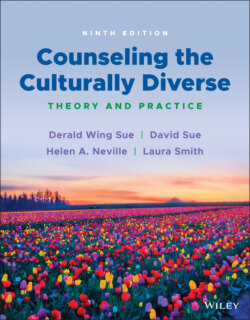Читать книгу Counseling the Culturally Diverse - Laura Smith L. - Страница 51
UNDERSTANDING THE THREE DIMENSIONS OF IDENTITY
ОглавлениеAll too often, counseling and psychotherapy seem to ignore the group dimension of human existence. For example, a White counselor who works with an African American client might intentionally or unintentionally avoid acknowledging the client's racial or cultural background by stating, “We are all the same under the skin” or “Apart from your racial background, we are all unique.” We have already indicated possible reasons why this happens, but such avoidance tends to negate an intimate aspect of the client's group identity (Apfelbaum, Sommers, & Norton, 2008; Neville, Gallardo, & Sue, 2016). Dr. D.'s responses toward Gabriella seem to have had this effect. These forms of microinvalidation will be discussed more fully in Chapter 4. As a result of these invalidations, a client of color might feel misunderstood and resentful toward the helping professional, hindering the effectiveness of counseling. Besides unresolved personal issues arising from counselors, the assumptions embedded in Western forms of therapy exaggerate the chasm between therapists and culturally diverse clients.
The concepts of counseling and psychotherapy, for example, are uniquely EuroAmerican in origin, as they are based on certain philosophical assumptions and values that are strongly endorsed by Western civilizations. On the one side are beliefs that people are unique and that the psychosocial unit of operation is the individual; on the other side are beliefs that clients are the same and that the goals and techniques of counseling and therapy are equally applicable across all groups. Taken to its extreme, this latter approach nearly assumes that Persons of Color, for example, are White, and that race and culture are insignificant variables in counseling and psychotherapy (Sue & Spanierman, 2020). Statements such as “There is only one race, the human race” and “Apart from your racial/cultural background, you are no different from me” are indicative of the tendency to avoid acknowledging how race, culture, and other group dimensions may influence identity, values, beliefs, behaviors, and the perception of reality (Sue, 2015).
FIGURE 2.1 Dimensions of Personal Identity Development
There is an East Asian saying that goes something like this: “All individuals, in many respects, are (a) like no other individuals, (b) like some individuals, and (c) like all other individuals.” Although this statement might sound confusing and contradictory, many East Asians believe these words to have great wisdom and to be entirely true with respect to human development and identity. We have found the three dimension framework shown in Figure 2.1 (Sue, 2001) to be useful in exploring and understanding the formation of personal identity. The three concentric circles illustrated in Figure 2.1 denote individual, group, and universal levels of personal identity.
